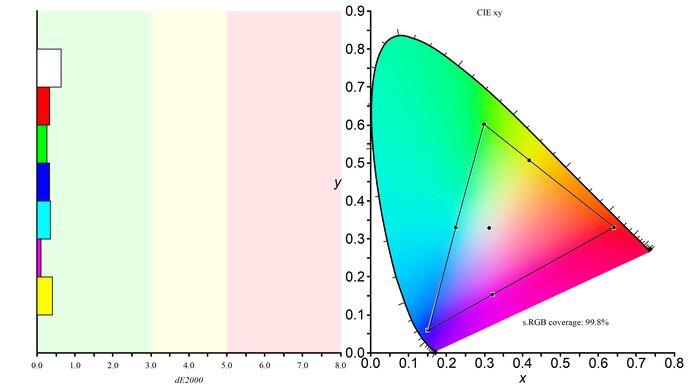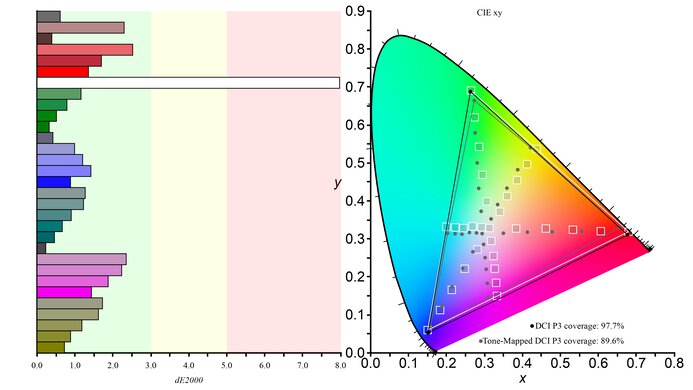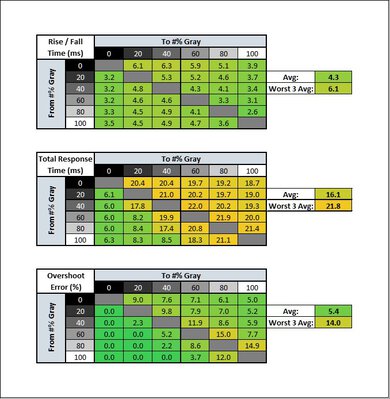The Dell Alienware AW2721D is an impressive 1440p gaming monitor. It has a 240Hz maximum refresh rate, an exceptional response time that results in minimal motion blur, and an incredibly low input lag that makes gaming feel responsive. It also has native G-SYNC support and is compatible with FreeSync to reduce screen tearing. It uses an IPS panel with wide viewing angles, but that comes at the expense of a lower contrast ratio, so blacks look more like gray when viewed in the dark. There's a local dimming feature to improve black levels, but it's not very effective. While it supports HDR and gets fairly bright for HDR content, its low contrast ratio means that the HDR experience is only decent. On the plus side, it gets bright enough to use in well-lit rooms, although it has mediocre reflection handling, so you may have issues with glare if you place it in front of bright lights.
Our Verdict
The Dell AW2721D is a great monitor for mixed usage. Gamers should be pleased with its exceptional response time, incredibly low input lag, and VRR support. It also has a high resolution and wide viewing angles that are great for productivity. Its wide color gamut and high peak brightness make images look crisp and clear, which is great for viewing and creating media. It supports HDR, although the HDR experience is only decent, and its low contrast ratio and bad black uniformity make it less suited to dark rooms.
- Exceptional response time.
- Wide viewing angles.
- High resolution and large screen size.
- Low contrast ratio.
- Mediocre reflection handling.
The Dell AW2721D is great for office use. Its high 1440p resolution and large size are well-suited to multitasking, with enough space to open multiple windows side-by-side. It also has wide viewing angles, which makes it easier to share content with a co-worker. Despite getting quite bright, its reflection handling is mediocre, so direct light can be distracting. That said, it has great ergonomics, allowing for many adjustments to suit your ideal viewing position.
- Wide viewing angles.
- Great ergonomics.
- High resolution and large screen size.
- Mediocre reflection handling.
- Poor black uniformity.
The Dell AW2721D is an impressive gaming monitor. It has a 240Hz refresh rate and an exceptional response time, resulting in clear motion. It also has an incredibly low input lag, so gaming feels responsive. It supports G-SYNC and is FreeSync compatible. Unfortunately, its IPS panel has a mediocre contrast ratio, so blacks look more like gray in the dark.
- Low input lag.
- VRR support.
- High refresh rate and an exceptional response time.
- Low contrast ratio.
- Mediocre reflection handling.
The Dell AW2721D is a great monitor for multimedia. Its high 1440p resolution makes images look crisp, and it's a good size for watching movies and TV on your own. Its wide viewing angles are good for watching with a friend. It performs well in bright rooms thanks to its high peak brightness, but it has mediocre reflection handling, so direct light sources might be distracting. On top of that, it has a mediocre contrast ratio, so it's not the best option if you prefer to watch in the dark.
- Wide viewing angles.
- Excellent brightness.
- High resolution and large screen size.
- Low contrast ratio.
- Mediocre reflection handling.
The Dell AW2721D is a great monitor for media creation. Its large screen size provides plenty of space, and its 1440p resolution makes images look crisp and clear. It has wide viewing angles, making it easy to share content with another person, and great ergonomics, allowing you to adjust it to your ideal viewing position. It also has an outstanding color gamut, including great coverage of the Adobe RGB color space used by professional content creators.
- Wide viewing angles.
- Great ergonomics.
- High resolution and large screen size.
- Low contrast ratio.
- Mediocre reflection handling.
- Low contrast ratio.
- Poor black uniformity.
- Bad local dimming.
Changelog
-
Updated Aug 11, 2025:
We changed the Screen Finish from 'Semi-Gloss' to 'Matte' to better reflect how its coating interacts with light.
- Updated Apr 18, 2023: Confirmed that 1440p works on this monitor with the PS5.
- Updated Nov 23, 2022: Clarified in the Variable Refresh Rate section that this monitor's replacement, the Dell Alienware AW2723DF, has native FreeSync support.
- Updated Nov 18, 2022: Lowered the Build Quality score from 9.0 to 8.5 because it feels like other Dell Alienware monitors, and it isn't a significant improvement from other models.
Check Price
Differences Between Sizes And Variants
We tested the Dell Alienware AW2721D, which is only available in a 27 inch size. There are similar monitors under Dell's Alienware label, and you can see the differences between them below.
| Model | Size | Panel | Resolution | Refresh Rate | Curved |
|---|---|---|---|---|---|
| AW2521H | 25" | IPS | 1080p | 360Hz | No |
| AW2521HF | 25" | IPS | 1080p | 240Hz | No |
| AW2521HFL | 25" | IPS | 1080p | 240Hz | No |
| AW2721D | 27" | IPS | 1440p | 240Hz | No |
| AW3821DW | 38" | IPS | 3840 x 1600 | 144Hz | Yes |
If someone comes across a different type of panel or their Dell Alienware AW2721D doesn't correspond to our review, let us know in the discussions and we'll update the review. Note that some tests, like gray uniformity, may vary between individual units.
Our unit was manufactured in September 2020. You can see the label here.
Popular Monitor Comparisons
The Dell Alienware AW2721D is an impressive and versatile gaming monitor that's well-suited for a variety of uses. It has one of the widest color gamuts and one of the highest brightness in HDR among the gaming monitors we've tested, and it has better build quality than some of its direct competitors, like the ASUS ROG Swift PG279QM. For more options, check out our recommendations for the best gaming monitors, the best 1440p gaming monitors, and the best monitors.
The Dell Alienware AW2721D and the ASUS ROG Swift PG279QM are very similar, each with strengths and weaknesses. The Dell has a better vertical viewing angle and better ergonomics, and it's brighter in both SDR and HDR. The ASUS, on the other hand, has better reflection handling and a wider color gamut, and it has built-in speakers.
The Dell Alienware AW2723DF is the replacement for the Dell Alienware AW2721D, and there are a few differences. The main difference is that the AW2723DF has native FreeSync support and G-SYNC compatibility instead of the native G-SYNC support on the AW2721D. This doesn't make much of a difference unless you have an NVIDIA graphics card, in which case, the AW2721D can take full advantage of it. Other than that, the AW2723DF has an overclockable 280Hz refresh rate and better motion handling, especially at lower refresh rates.
The Dell Alienware AW2721D and the LG 27GP850-B/27GP83B-B offer similar performance all-around, but there are some differences between them, so which one is better depends on your needs. The Dell has much better ergonomics, so it's easier to place in an ideal viewing position, and it seems to have much better build quality. If those don't matter to you, the LG has a better response time and an optional black frame insertion feature to improve motion handling.
The ASUS ROG Swift PG279Q and the Dell Alienware AW2721D are both 27 inch, 1440p gaming monitors with native G-SYNC support. Although the Dell has a higher refresh rate and lower input lag, casual gamers might not notice the difference. The Dell supports HDR, whereas the ASUS doesn't, and it also has more USB ports.

We buy and test more than 30 monitors each year, with units that we buy completely on our own, without any cherry-picked units or samples. We put a lot into each unbiased, straight-to-the-point review, and there's a whole process from purchasing to publishing, involving multiple teams and people. We do more than just use the monitor for a week; we use specialized and custom tools to measure various aspects with objective data-based results. We also consider multiple factors before making any recommendations, including the monitor's cost, its performance against the competition, and whether or not it's easy to find.
Test Results

The Dell AW2721D has a sleek, gamer-oriented design, similar to previous Alienware monitors. It's mostly white with black accents and has thin borders. It also has four RGB lighting zones, including the downlight beneath the panel, the power button, the Alienware logo on the back, and the stand. It's heftier than similar-looking models like the Dell Alienware AW2720HF due to the more premium materials used in the stand.
The Dell AW2721D has great ergonomics. The swivel range is a bit limited, but it allows for a lot of height and tilt adjustments. It can also rotate into portrait mode in both directions. The back of the monitor is made of plastic with an Alienware logo in the top right corner that lights up. There's a cutout in the stand for cable management.
The stand supports the monitor well, with very little wobble. It's capped in plastic, but most of the structure is metal, so it feels heavier and sturdier than previous Alienware monitors.
The Dell AW2721D includes an edge-lit local dimming feature, but it's not especially effective. There are quite a few dimming zones, so there's not as much blooming as other edge-lit monitors, but there's still blooming along the whole height of the screen, and transitions between zones are fairly noticeable. There are also noticeable differences in uniformity when the vertical zones are lit up. That said, these issues are less noticeable with real content.
Note: While we've received reports that some people experience better local dimming on Mode 0, we chose to test local dimming using Mode 1 because it was the brightest and offered the best compromise between increased contrast and transition visibility. That said, we don't expect using a different local dimming mode to significantly affect the score.
The Dell Alienware AW2721D has excellent SDR peak brightness, higher than the advertised 450 cd/m2, so you shouldn't have issues using the monitor in well-lit rooms. With local dimming disabled, the brightness is more consistent, and it gets up to 575 cd/m2 in the sustained 100% window, which is significantly brighter than what you get with local dimming enabled.
We measured the SDR brightness after calibration in the 'Custom' Picture Mode, with Brightness set to max, and local dimming (Variable Backlight) set to 'Mode 1'.
The HDR peak brightness is good. Small highlights are significantly brighter than in SDR, reaching well above the advertised 600 cd/m2.
We measured HDR brightness in the 'Gamer 1' Picture Mode with Smart HDR enabled, Brightness set to max, and local dimming (Variable Backlight) set to 'Mode 1'.
The Dell AW2721D has good horizontal viewing angles. The image remains mostly accurate when viewed from the sides, so it should be fine for sharing content or co-op gaming.
The Dell AW2721D has impressive vertical viewing angles, which is great if you're sitting up close or have the monitor raised. There's some slight color washout at extreme angles, but for the most part, colors and black levels remain accurate.
The Dell AW2721D has great out-of-the-box color accuracy. There are slight inaccuracies in most colors and shades of gray, but they're hard to notice. For the most part, gamma doesn't follow the curve, so most scenes appear brighter than they should. The color temperature is a bit cooler than our 6500k target, giving the image a blue-ish tint. Note that accuracy may vary between units.
After calibration, accuracy is incredible. Any remaining accuracies shouldn't be noticeable without the help of a colorimeter. Gamma follows the curve closely for the most part, and the color temperature is much closer to the target.
The Dell AW2721D has a remarkable SDR color gamut. It has nearly perfect coverage of the commonly used sRGB color space and great coverage of the Adobe RGB color space used by professional content creators.
SDR color volume is exceptional. Thanks to its remarkable color gamut and high peak brightness, it displays colors in a wide range of luminance levels. Unfortunately, its mediocre contrast ratio means it struggles to display dark, saturated colors.
The Dell AW2721D has mediocre reflection handling, worse than the ASUS ROG Swift PG279QM. It uses a matte coating that doesn't adequately diffuse indirect light, so reflections may be distracting in bright rooms. If you're looking for something with better reflection handling, then look into the HP OMEN 27c.
The Dell AW2721D has an exceptional 240Hz refresh rate with a wide VRR range. It has native G-SYNC support and is FreeSync compatible, but FreeSync only works over a DisplayPort connection. Unfortunately, you can only get up to 144Hz with 10-bit color at native resolution. You can get higher frame rates in 10-bit if you lower your resolution or by going down to chroma 4:2:2. If you don't need the native G-SYNC support and prefer something with native FreeSync, then check out this monitor's replacement, the Dell Alienware AW2723DF.
| Overdrive Setting | Response Time Chart | Response Time Tables | Motion Blur Photo |
| Fast | Chart | Table | Photo |
| Super Fast | Chart | Table | Photo |
| Extreme | Chart | Table | Photo |
The Dell Alienware AW2721D has an exceptional response time at its max refresh rate of 240Hz. The recommended overdrive setting is 'Fast' because it gives you the best performance, with minimal overshoot.
| Overdrive Setting | Response Time Chart | Response Time Tables | Motion Blur Photo |
| Fast | Chart | Table | Photo |
| Super Fast | Chart | Table | Photo |
| Extreme | Chart | Table | Photo |
The response time at 60Hz is excellent, although not as fast as at the max refresh rate. The best overdrive setting with the least amount of overshoot is the 'Fast' setting. If you play low-frame-rate games and care about the 60Hz response time, then look into the Dell G2722HS.
This monitor doesn't have a Black Frame Insertion feature.
The Dell AW2721D has an exceptionally low input lag. It's a little higher at 60Hz and with VRR enabled, but it shouldn't be noticeable for most people.
The Dell AW2721D has a 1440p resolution and high pixel density, resulting in a crisp image. The 27 inch screen provides plenty of space for multitasking and makes for an immersive gaming experience.
This monitor has a USB hub with three USB 3.0 inputs, but it lacks a USB-C inputs. If that's what you want, then check out the Razer Raptor 27 165Hz.
There are no issues using this monitor with a recent M1 MacBook Pro. HDR works perfectly. The variable refresh rate feature works well, but there's a bit of flickering at low refresh rates, and there are no issues when putting the computer to sleep or closing the lid. It wakes up quickly, and windows return to their original position.
The Dell AW2721D has a few extra features, including:
- RGB Lighting: RGB lighting zones on the back of the monitor, the stand, the downlight beneath the panel, and the power button. These can be customized through the AlienFX software.
- Display Alignment: Helps with alignment in a multi-monitor setup.
- Timer: Displays a timer onscreen.
- FPS Counter: Displays an overlay that shows the current frame rate.





















































